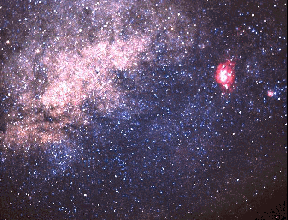
The History of Cosmic Ray Studies
1900 - 1949
- 1900
- Paul Villard described gamma rays
- 1900
- Max Planck put forward his quantum theory
- 1901
- First Nobel Prize awarded in physics (to Roentgen)
- 1905
- Albert Einstien published his theory of Special Relativity and
introduced the idea of discrete packets of energy, later called
"photons"
- 1908
- George Hale demonstrated that sunspots are produced by strong
magnetic fields
- 1909
- The amount of charge in an electron was determined by Robert
Millikan
- 1911
- Ernest Rutherford discovered the atomic nucleus
- 1911
- Charles Wilson invented a cloud chamber, which was used to detect
alpha and beta particles and electrons
- 1912
- Cosmic ray research began in 1912 when Victor Hess, of the Vienna University, and 2 assistants flew in a balloon to an altitude of about 16,000 ft. They discovered evidence of a very penetrating radiation (cosmic rays) coming from outside our atmosphere. In 1936, Hess was awarded the Nobel prize for this discovery.
- 1913
- Niels Bohr proposed that atoms contain orbital shells of electrons
- 1914
- Ernest Rutherford discovered the proton
- 1916
- Albert Einstein published his General Theory of Relativity
- 1920
- Harlow Shapley and Heber Curtis: The Great Debate over the scale and structure of the universe
- 1920
- Ernest Rutherford proposed the existence of the neutron
- 1920
 Harkins and Eddington found that the fusion of hydrogen could be the energy source of stars. Image of Sagittarius star cloud is courtesy of NASA/ARC.
Harkins and Eddington found that the fusion of hydrogen could be the energy source of stars. Image of Sagittarius star cloud is courtesy of NASA/ARC.- 1922
- Russian physicist/mathematician Alexander Freedmann predicted that the universe is expanding
- 1925
- Robert Millikan introduced the term "cosmic rays"
- March 16, 1926
- Robert Goddard, for whom the NASA Goddard Space Flight Center is named, fired the first liquid fuel rocket.
- 1928
- Paul Dirac predicted that for every particle, there is a
corresponding anti-particle that is exactly like the particle but with
opposite charge = antimatter
- 1929
- Using a newly invented cloud chamber, Dimitry Skobelzyn observed
the first ghostly tracks left by cosmic rays
- 1929
- Walter Bothe and Werner Kolhorster verified that the Skobelzyn's
cloud chamber tracks are curved, showing that cosmic rays are charged
particles
- 1930
- Ernest Lawrence invented the cyclotron, the first particle
accelerator, for which he received the Nobel Prize in 1939
- 1930
- Wolfgang Pauli proposed the existence of the neutrino
- 1930
- Invention of the coronograph by Bernard Lyot
- 1932
- James Chadwick discovered the neutron
- 1932
- Carl Anderson discovered antimatter (positrons) in his cloud
chamber. He shared the 1936 Nobel Prize with Victor Hess for his
work.
- 1932
- John Cockroft and Ernest Walton used a particle accelerator to
split the atom
- 1932
- Dr. Robert A. Millikan of Caltech, winner of the 1923 Nobel prize in physics, completed a series of tests on the intensity of cosmic rays at various altitudes in a Condor bomber from March Field, Calif.
- 1935

Explorer II, a 113,000 cubic foot rubberized helium balloon ascended to the official record of 22,066 m while collecting atmospheric, cosmic ray, and other data.- 1935
- Hideki Yukawa predicted the existence of mesons, for which he won
the 1949 Nobel Prize
- 1937
- Seth Neddermeyer and Carl Anderson discovered the muon (for mu
meson) in cosmic rays
- 1937
- First artificial element, technetium, was created
- 1938
- Otto Hahn and Fritz Strassmann discovered nuclear fission
- 1938
- Pierre Auger discovered "extensive air showers", showers of
secondary subatomic particles caused by the collision of high energy
cosmic rays with air molecules
- 1940
- A Beechcraft AD-17 biplane was flown to an altitude of 21,050 ft over the Antarctic to measure cosmic rays for the U.S. Antarctic Expedition.
- 1947
- Pions (for pi mesons) were discovered by Cecil Powell.
- 1947
- Physicist Martin Pomerantz announced at Swarthmore College that he had sent a flight of four free balloons, carrying cosmic ray equipment, to a record height of at least 127,000 feet over the Antarctic.
- 1948
- Bethe and Gamow explained nucleosynthesis in a hot big bang.
- 1949
- Enrico Fermi proposed that cosmic ray protons are accelerated by
bouncing off moving magnetic clouds in space, as in the shock waves
around a supernova
Back to main history page






Click on images above to
learn more about them
A service of the Heliophysics
Science Division at NASA's GSFC
Questions and comments to: cosmicopia@cosmicra.gsfc.nasa.gov
Curator: Dr Eric R. Christian, NASA
Responsible NASA Official: Dr Eric R. Christian
Privacy Policy and Important Notices
Questions and comments to: cosmicopia@cosmicra.gsfc.nasa.gov
Curator: Dr Eric R. Christian, NASA
Responsible NASA Official: Dr Eric R. Christian
Privacy Policy and Important Notices

HOME
In the News
History
Ask Us
Great Links
Glossary
Site Map
Search NASA